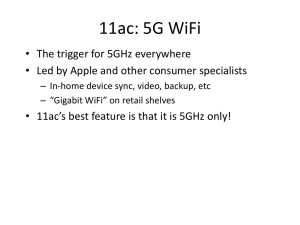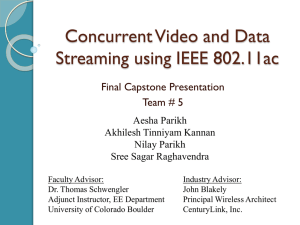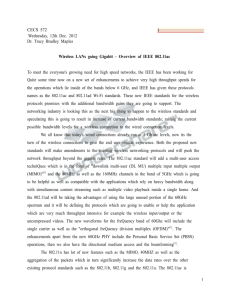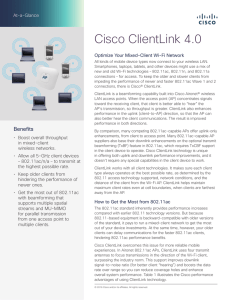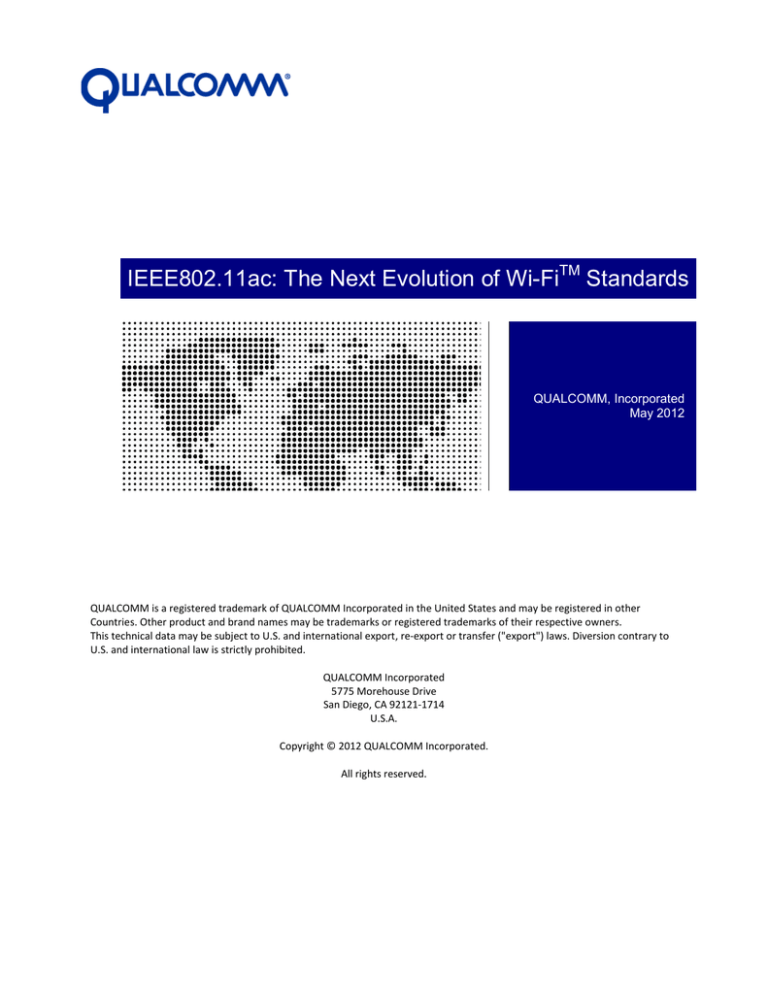
IEEE802.11ac: The Next Evolution of Wi-FiTM Standards
QUALCOMM, Incorporated
May 2012
QUALCOMM is a registered trademark of QUALCOMM Incorporated in the United States and may be registered in other
Countries. Other product and brand names may be trademarks or registered trademarks of their respective owners.
This technical data may be subject to U.S. and international export, re-export or transfer ("export") laws. Diversion contrary to
U.S. and international law is strictly prohibited.
QUALCOMM Incorporated
5775 Morehouse Drive
San Diego, CA 92121-1714
U.S.A.
Copyright © 2012 QUALCOMM Incorporated.
All rights reserved.
IEEE802.11ac: The Next Evolution of
Wi-FiTM Standards
Table of Contents
Executive Summary .............................................................................. 1
[1] Introduction ...................................................................................... 2
[2] New Features in 802.11ac ............................................................... 2
2.1 Mandatory 5 GHz Operation.................................................... 3
2.2 Wider Bandwidth ..................................................................... 3
2.3 Higher Order Modulation ......................................................... 4
2.4 Higher Order MIMO ................................................................. 5
2.5 Multi-User MIMO (MU-MIMO) ................................................. 5
2.6 Dynamic Bandwidth Management ........................................... 6
2.7 Single-Method Closed Loop Transmit Beamforming .............. 8
2.8 Backwards Compatibility ......................................................... 9
[3] 802.11ac Usage Model Example: In-home HD content
distribution ....................................................................................... 9
[4] 802.11ac HD Content Distribution Performance............................ 10
[5] Conclusion ..................................................................................... 11
[6] APPENDIX ..................................................................................... 12
6.1 Mandatory and Optional features in 802.11ac ...................... 12
[7] Glossary ......................................................................................... 12
Page i
IEEE802.11ac: The Next Evolution of Wi-FiTM
Standards
Executive Summary
Traditionally Wi-Fi® was a means for users to stay connected at home or in the
enterprise to the internet and check emails, or surf the web. Today, that trend is
rapidly changing whereby Wi-Fi is being used for content consumption such as
streaming music and videos. Demand for video content is driven by easy-to-use video
streaming services such as Netflix, YouTube, etc. Many users demand high-definition
(HD) video content on set-top-boxes, TVs, laptops, and on their mobile devices such
as smart phones and tablets. HD video content, as well as video content in general,
presents a challenge for existing Wi-Fi 802.11n based networks, as they suffer from
interference in the 2.4 GHz band.
802.11ac is the next evolution of the Wi-Fi standard that promises to deliver multiple
HD video streams simultaneously. It can reach maximum throughputs well above a
Gigabit per second. The 802.11ac specification mandates operation in the 5 GHz
band, where there is relatively less interference and more channels are available
compared to the 2.4 GHz band. 802.11ac achieves higher performance than 802.11n
by using more spatial streams, wider bandwidth, higher order modulation, and
improved bandwidth management techniques. Downlink Multi-user MIMO (MUMIMO) 1 is an advanced feature defined in the 802.11ac standard that allows
simultaneous multiple transmissions from the access point (AP) to up to four client
stations (STAs). MU-MIMO mode increases client performance even with fewer
antennas. With the proliferation of smart phones that have limited space, requiring
only a single antenna is an especially attractive benefit as these smart phones
experience higher throughputs while reducing cost and space.
This paper explains the new features of the IEEE 802.11ac standard. It also compares
the performance results of 802.11n and 802.11ac for an in-home HD video content
distribution scenario defined by IEEE. These simulation results indicate that 802.11ac
can sustain significantly higher throughput and lower latency than 802.11n.
1
MU-MIMO is an optional feature which is not part of Wi-Fi Alliance’s initial 802.11ac product certification
Page 1
IEEE802.11ac: The Next Evolution of Wi-FiTM
Standards
[1] Introduction
To fulfill the promise of increasing Wi-Fi performance, effectively supporting more
client devices on a network and delivering multiple HD video streams simultaneously,
the IEEE group has been working on 802.11ac, a new standard that is in its advanced
stages of standardization. The 802.11ac Draft 2.0 specification was released in
February 2012 and leverages new technologies to provide improvements over
802.11n. It is also the first Wi-Fi standard to exceed the Gigabit–per-second
throughput barrier.
Wi-Fi is playing an increasingly important role in home networking as it has consumer
familiarity and a low cost of installation. There is a growing trend in homes to distribute
multiple HD video streams and other high-bandwidth content to devices like HDTVs,
laptops, tablets, and smart phones. Delivering multiple simultaneous HD video
streams wirelessly requires a robust, low-latency, and high throughput Wi-Fi network.
Wi-Fi based on 802.11n improved the performance compared to previous 802.11a/b/g
standards. It increased the theoretical peak data rates to 600 Mbps compared to 54
Mbps. In order to get to these high rates and coverage however, it relied on singleuser MIMO and beamforming. However, beamforming did not get widely adopted by
the industry due to lack of a commonly specified mode. In addition, with multiple
users, single-user MIMO relied on time-division multiplexing of the MIMO streams,
which reduced overall throughput.
802.11ac overcomes the above limitations and achieves a maximum throughput of
6.93 Gbps in 160 MHz bandwidth mode in the 5 GHz band, using eight spatial
streams and 256 QAM modulation. 802.11ac has also specified multi-user MIMO (MUMIMO), which allows simultaneous transmission of MIMO streams to multiple client
devices. In addition, 802.11ac has defined a single closed-loop method for transmit
beamforming, which is expected to be an optional feature of the Wi-Fi Alliance
certification plan. 802.11ac has also introduced dynamic bandwidth management to
optimize the use of available bandwidth. These new features of 802.11ac deliver the
next leap in performance, which also includes simultaneous streaming of multiple HD
video streams.
[2] New Features in 802.11ac
Page 2
IEEE802.11ac: The Next Evolution of Wi-FiTM
Standards
2.1 Mandatory 5 GHz Operation
Previous Wi-Fi standards such as 802.11a/b/g/n operate in the 2.4 GHz band with
802.11n optionally supporting the 5 GHz band. The 802.11ac standard mandates
operation only in the 5 GHz band. 2.4 GHz band is susceptible to greater interference
from crowded legacy Wi-Fi devices as well as many household devices. The 5 GHz
band has relatively reduced interference and there are a greater number of nonoverlapping channels available (25 non-overlapping channels in US) compared to the
2.4 GHz band (3 non-overlapping channels in the US). 802.11ac is therefore expected
to leverage the reduced interference and greater flexibility of multiple available
channels in the 5 GHz band for increased performance.
2.2 Wider Bandwidth
802.11ac introduces 80 MHz and 160 MHz channel bandwidths in addition to the 20
MHz and 40 MHz specified in 802.11n. The 802.11ac standard requires all devices to
support 20, 40, and 80 MHz channel bandwidths in the 5GHz band, with support of
160 MHz channel bandwidth being optional. 80 MHz channels can only be formed by
combining two adjacent, non-overlapping 40 MHz channels. The optional 160 MHz
channel can be formed by combining two adjacent or two non-adjacent 80 MHz
channels. The wider channel bandwidths of 802.11ac are shown in Figure 1.
Figure 1: Wider Channel Bandwidths in 802.11ac (5 GHz Band)
Page 3
IEEE802.11ac: The Next Evolution of Wi-FiTM
Standards
Wider bandwidth allows higher data rates to be achieved. In 160 MHz mode, the
maximum data rate that can be achieved using eight spatial streams, 256 QAM
modulation, and code rate 5/6 is 6.933 Gbps. However, initial 802.11ac products will
typically use 80 MHz bandwidth and be implemented in single-stream configuration for
handsets and tablets, and up to three spatial streams in routers for a maximum
achievable PHY data rate of 1.3 Gbps, slightly more than double the maximum data
rate of 802.11n using four spatial streams. Table 1 shows the maximum possible data
rates in 802.11ac depending on the highest possible modulation and coding scheme
for a given bandwidth and given number of spatial streams. With gigabit throughputs
Table 1: 802.11ac Maximum Achievable PHY Data Rates
easily achievable, 802.11ac promises to deliver high performance and address the
capacity requirements of in-home HD content distribution.
2.3 Higher Order Modulation
In 802.11n the highest order modulation is 64-QAM (Quadrature Amplitude
Page 4
Figure 2: Higher Order Modulation (256-QAM) in 802.11ac
IEEE802.11ac: The Next Evolution of Wi-FiTM
Standards
Modulation). Six bits of coded information can be represented in a 64-QAM
constellation. 802.11ac increased the constellation configuration to 256-QAM that
provides an incremental increase in data rates by 33% over 11n. This increase is
achieved by representing eight coded bits per symbol instead of six. It should be noted
however that higher signal-to-noise ratio (SNR) is required for 256-QAM compared to
64-QAM because the constellation symbols are closer to each other, as a result
making them more susceptible to noise.
Figure 2 shows the impact of 256-QAM on performance. 600 Mbps is the maximum
achievable PHY data rate in 802.11n using four spatial streams and 40 MHz
bandwidth. However, for the same configuration, 802.11ac achieves 800 Mbps. These
data rates assume the short guard interval option.
2.4 Higher Order MIMO
802.11n was the first standard that introduced single-user multiple-input, multipleoutput (MIMO) transmissions. 802.11n allowed a maximum of four MIMO streams that
could be sent to a single device at a time. This increased throughput over the previous
standards such as 802.11a/b/g. 802.11ac further increased the maximum number of
MIMO streams from four to eight. An 802.11ac STA can now receive up to eight
spatial streams, to effectively double the total network throughput of 802.11ac
compared to 802.11n.
2.5 Multi-User MIMO (MU-MIMO)
802.11ac is the first Wi-Fi standard that introduces multi-user MIMO (MU-MIMO). In
MU-MIMO, the AP can serve multiple STAs simultaneously. This technique allows the
AP transmitter to send multiple packets simultaneously to multiple STAs. This is
achieved using up to eight spatial streams that can be divided among up to four STAs.
These STAs can employ different numbers of spatial streams. Each individual STA
can have a maximum of four spatial streams in an MU-MIMO transmission. For
example, a configuration can include four STAs each with two antennas, and an eight
antenna AP forms a four-way MU-MIMO to serve all four STAs with data on two
spatial streams each. Without MU-MIMO, the AP would have to multiplex the four
STAs and serve them one at a time, thus effectively reducing their throughputs by a
factor of four.
Page 5
IEEE802.11ac: The Next Evolution of Wi-FiTM
Standards
Single user MIMO (SU-MIMO) has to time-division multiplex the data to support
multiple STAs and requires more antennas for reception, increasing the device cost.
As shown in Figure 3 for example, if an AP has three antennas and there are three
Figure 3: Multi-User MIMO (MU-MIMO)
STAs in an SU-MIMO system, each STA requires three antennas to receive data from
the AP one-third of the time to achieve the same throughput as that of an MU-MIMO
STA with a single antenna. In an MU-MIMO scenario with the same three-antenna AP,
the three STAs require only a single antenna to receive the same throughput as that of
the SU-MIMO case. All three STAs in MU-MIMO case simultaneously receive a single
spatial stream from the AP 100% of the time.
MU-MIMO is especially beneficial with the proliferation of smart phones. With faster
throughput, power consumption can be reduced and with only a single antenna
required instead of three, cost and space requirements are reduced.
2.6 Dynamic Bandwidth Management
Bandwidth management is an important aspect of any Wi-Fi standard. 802.11ac has
several bandwidth combinations allowed from 20 MHz to 160 MHz wide channels.
With this increase in available channel bandwidth comes greater flexibility. However,
with this greater flexibility, comes the challenge of optimizing the use of wider
bandwidth in an efficient manner. Each 802.11ac network includes a 20 MHz primary
channel. This primary channel is accessed using carrier sensing to make sure the
channel is free from interference from other networks. Another use for the primary
channel is co-existence and backwards compatibility with older Wi-Fi standards. Once
the access to the primary channel is obtained, additional secondary channels for wider
bandwidth may be added.
Only 20, 40, 80, and 160 MHz bandwidths are allowed in 802.11ac. 60 and 120 MHz
bandwidths are not allowed. To manage a set of primary and secondary channels in a
Page 6
IEEE802.11ac: The Next Evolution of Wi-FiTM
Standards
wide bandwidth configuration, 802.11ac introduced a new concept of dynamic
bandwidth management. 802.11n did not properly define a handshake (ready to
send/clear to send, or CTS/RTS) mechanism for bandwidth management. This
sometimes caused the bandwidth of the receiver to not strictly relate to the actual
bandwidth available at the receiver. This is shown in Figure 4. In this case the sender
has no interference in both the primary and secondary channels; however, the
receiver has interference in the secondary channel. The sender sends the handshake
signal called ready to send (RTS) on both channels. The receiver cannot acknowledge
its respective handshake signal called clear to send (CTS) on either primary or
secondary channel as that is the protocol in static mode. As a result, no transmission
occurs in this case.
On the other hand, in dynamic mode defined in 802.11ac, channel interference is
Figure 4: Static and Dynamic Bandwidth Management
measured per channel, and the receiver can send CTS signals per channel to indicate
which channels are interference-free. In this case transmission is allowed to take
place on the primary channel, which improves overall bandwidth utilization and
network performance.
Page 7
IEEE802.11ac: The Next Evolution of Wi-FiTM
Standards
In 802.11ac the interference detection threshold has also improved. Wi-Fi APs use
interference detection to reduce overlap and collisions with other APs operating on
secondary channels. The standard defines a sensitivity threshold for the signal
strength on the secondary channel that an AP must measure in order to determine if
Figure 5: Improved Sensitivity of CCA Threshold in 802.11ac
that secondary channel is busy. Shown in Figure 5 is an example to illustrate this
concept. 802.11n uses -62 dBm as the sensitivity threshold for inferring 802.11n
signals, whereas 802.11ac improved this to -72 dBm, which means that 802.11ac
networks have improved sensitivity towards collision avoidance and overlap detection.
Dynamic bandwidth management and increased sensitivity of the clear channel
assessment (CCA) threshold are additional features that improve the performance of
802.11ac and help meet the requirements of in-home HD content distribution.
2.7 Single-Method Closed Loop Transmit Beamforming
In MIMO channels, beamforming is a technique that focuses the APs transmit energy
of the MIMO spatial streams towards the target STAs. This is achieved by using
channel estimation to precode the transmission in such a manner that when the
transmitted streams reach the STA they optimally combine their energies thus
producing a stronger signal as seen by the STA. In 802.11n, several methods of
beamforming were defined, however none of them was mandated for certification and
as a result, chipset vendors implemented a variety of non-interoperable techniques.
Lack of a single method prevented this feature of 802.11n from providing the intended
range enhancements across end-products, and becoming mainstream.
The 802.11ac standard defines a single closed-loop method for transmit beamforming.
In this method, the AP transmits a special sounding signal to all STAs who estimate
the channel and report their beamforming matrices back to the AP. This feedback from
Page 8
IEEE802.11ac: The Next Evolution of Wi-FiTM
Standards
STAs is standardized so that APs and STAs from different vendors would still
interoperate correctly as long as they are certified to be standard compliant.
Transmit beamforming (TxBF) is an optional feature in the 802.11ac specification and
it will be an optional-tested item in the Wi-Fi certification testing. TxBF is a technique
that can enable a higher modulation and coding scheme (MCS) at a given range.
TxBF does not extend the maximum range or increase the maximum rate. In the 5
GHz band, regulatory requirements limit the transmit power that reduces the TxBF
gain. The reduction in power depends on the array gain which is a quantity
proportional to the number of antennas used at the transmitter.
2.8 Backwards Compatibility
802.11ac is an IEEE standard amendment to 802.11n specification. It is required to be
fully compatible with 802.11n and 802.11a. 802.11ac only applies to 5 GHz band
because there are no 80 MHz and 160 MHz channels available in the 2.4 GHz band.
802.11ac standard enables coexistence with 802.11n/a devices by requiring a
backwards compatible preamble that has a section which is understandable by
802.11n/a devices. This would allow legacy devices to operate as intended.
[3] 802.11ac Usage Model Example: In-home HD content
distribution
IEEE has defined various usage models for 802.11ac. For the purpose of this paper,
we focus on the models developed for distributing compressed video streaming
throughout the whole home. This usage model addresses the increasing requirement
Page 9
Figure 6: In-home HD Content Distribution
IEEE802.11ac: The Next Evolution of Wi-FiTM
Standards
from service providers who want the home network to support multiple HD streams.
Content comes into the home over a wired link such as DSL, Fios, or Cable. A set-topbox (STB) combined with a Wi-Fi access point (AP) can receive this content.
Alternatively, there can be locally stored content in a media server. The STB/AP
distributes multiple HD video streams wirelessly to HDTVs or other set-top-boxes
throughout the home. This eliminates the restrictions on placing STBs very close to
wall outlets as done today. With Wi-Fi, the flexibility to place the STB increases, and
makes it more convenient to install an HDTV anywhere in the home.
An in-home HD content distribution usage model shown in Figure 6 defines four
wireless video streams. Two HD video streams at 24 Mbps each go to two HDTVs in
two separate rooms. One Blu-ray video stream at 54 Mbps comes from the media
server to the AP, and one Blu-ray video stream goes from the AP to a Blu-ray TV.
Real path losses are modeled to reflect the distance between different rooms within
the home and wall penetration losses.
802.11ac is a suitable technology to address this scenario. It achieves high
throughputs, low latencies, and reduced cost using many of the advanced features
introduced in the standard.
[4] 802.11ac HD Content Distribution Performance
Figure 7 shows the simulation results for the in-home HD content distribution scenario
shown in Figure 6. Both 802.11n and 802.11ac operate at 40 MHz bandwidth. 802.11n
uses four antenna AP and each client uses four antennas. Additional antennas
increase the cost of the solution. 802.11ac uses eight antenna AP and only two
Figure 7: In-Home HD Content Distribution Simulation Result: 802.11n (Left) 802.11ac (Right)
Page 10
IEEE802.11ac: The Next Evolution of Wi-FiTM
Standards
antenna clients which reduces cost of the solution. 802.11n cannot sustain the
downlink Blu-ray reception by the TV because of the required 54 Mbps in presence of
the other stream. 802.11ac on the other hand successfully streams the Blu-ray to the
TV by achieving 54 Mbps throughput and by keeping the delay well below one
millisecond.
[5] Conclusion
The IEEE 802.11ac standard leverages new technologies to achieve Gigabit per
second throughputs. Smoother in-home HD video content distribution can be achieved
using 802.11ac over a robust high throughput, low latency Wi-Fi network.
Improvements in performance come from wider bandwidth, more spatial streams,
higher order modulation, dynamic bandwidth management, and multi-user MIMO. In
addition, 5 GHz operation allows for reduced interference. Small form factor devices
such as smart phones sensitive to space and cost can enjoy higher throughputs with
single antennas.
Simulation results show 802.11ac in 40 MHz bandwidth using eight antenna AP can
easily support two HD video streams at 24 Mbps each and two Blu-Ray video streams
at 54 Mbps each. The additional benefit is the cost reduction at the client that only
requires two antennas. Thus 802.11ac is a promising technology that can robustly
deliver simultaneous HD video streams throughout the home.
Initial pre-certification 802.11ac devices are starting to become available this year. WiFi certification is expected to start in the first quarter of 2013. Multi-user MIMO
certification is expected to start some time in the first half of 2014.
Page 11
IEEE802.11ac: The Next Evolution of Wi-FiTM
Standards
[6] APPENDIX
6.1 Mandatory and Optional features in 802.11ac
Mandatory
Optional
5GHz operation
20, 40, and 80MHz channels
1 Spatial Stream in clients
2 Spatial streams in APs
MCS 0-7 (BPSK, r=1/2 through 64-QAM, r=5/6)
VHT A-MPDU delimiter for Rx and Tx for single MPDU
Rx A-MPDU and Tx A-MPDU
Clear Channel Assessment (CCA) on Secondary
CTS with BW signaling in response to RTS with BW
signaling
160MHz channels
80+80MHz channels
2 or 3 Spatial Streams (Tx and Rx) in clients and
APs
4 Spatial Streams in clients and APs
MCS 8 (256-QAM, r=3/4)
MCS 8-9 (256-QAM, r=3/4 and r=5/6)
Rx A-MPDU of A-MSDU
Short Guard Interval (GI)
RTS with BW signaling
MU-MIMO
Transmit beamforming (TxBF)
AP STBC Tx 2x1 and STA STBC Rx 2x1
TXOP sharing
VHT TXOP power save
Low Density Parity Check (LDPC) coding
[7] Glossary
A-MPDU
Aggregate MAC Protocol Data Unit
A-MSDU
Aggregate MAC Service Data Unit
AP
Access Point
CCA
Clear Channel Assessment
CTS
Clear To Send
DSL
Digital Subscriber Line
HD
High Definition
HDTV
High-Definition Television
IEEE
Institute of Electrical and Electronics Engineers
LDPC
Low Density Parity Check
MIMO
Multiple Input Multiple Output
MU-MIMO
Multi User Multiple Input Multiple Output
PHY
Physical Layer
Page 12
IEEE802.11ac: The Next Evolution of Wi-FiTM
Standards
QAM
Quadrature Amplitude Modulation
RTS
Ready to Send
STA
Station
STB
Set Top Box
STBC
Space Time Block Coding
SU-MIMO
Single User Multiple Input Multiple Output
TxBF
Transmit Beamforming
TXOP
Transmit Opportunity
VHT
Very High Throughput
Page 13

